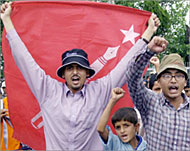Nepal: A brief history of the conflict
Despite a series of attempts to resume peace talks, an end to a conflict that has claimed more than 7000 lives in the past seven years remains elusive.

The current rebellion, pitting government forces against Maoist rebels, is the latest bloody episode in a story of political instability that has plagued this Himalayan mountain state for decades.
Nominally independent since 1923, the kingdom remained under strong British influence till the 1950s. The country joined the United Nations in 1955, the year King Mahendra acceded to the throne.
From 1959, the kingdom briefly flirted with multi-party democracy – an issue at the heart of the current conflict. But when the centre-left Nepali Congress Party (NCP) won the elections in 1960, King Mahendra staged a coup and suspended parliament, the constitution and multi-party politics.
This sowed the seeds of strife whose fruit can still be seen today. After King Birendra succeeded Mahendra in 1972, popular agitation for greater democracy began to grow. Eventually, Birendra agreed to allow non-party politics back into national assembly in 1980.
But this failed to placate all Nepalese and after a year of popular street protests, elections were held in 1991. The Nepali Congress Party formed a government led by Prime Minister Girija Prasad Koirala.
Rise of the Maoists
A broad grouping of more radical leftists came to prominence in the 1990s, and in 1994 a communist government took power. This posed a severe challenge to the monarchy and its upper caste supporters, who succeeded in dissolving the communist government in 1995.
 |
|
Maoists draw their support from |
The radical left quickly split into seven different factions and the hard line Communist Party of Nepal (Maoist) began its insurgency in rural areas.
The Maoists demanded the formation of a communist people’s republic. They argued that Nepal’s many minorities had suffered discrimination because of the upper caste-dominated power structure.
The Maoists drew much of their support from people of Tibeto-Burman stock and the Dalit caste – the so-called Untouchables. The group also pushed a progressive women’s rights agenda and consequently enjoyed strong support among rural women. As the conflict worsened, one in three Maoist rebels in their rural strongholds were women.
The NCP returned to government, but was itself soon beset with in-fighting. Sher Bahadur Deuba became prime minister in 1997, but soon the premiership was changing hands every year till the end of the decade. GP Koirala returned to power in 2000 – the ninth government in 10 years.
A year later, the Maoists brought the country to a standstill with a general strike.
Bloodshed worsens
The year 2001 witnessed some extraordinary violence. In a bizarre incident, King Birendra, Queen Aishwarya and other family members were shot dead in June when a drunken Crown Prince Dipendra opened fire on them, before shooting himself dead. Prince Gyanendra took the throne soon afterwards.
Meanwhile, the Maoists escalated their insurgency and the mounting violence saw Deuba take the premiership back from Koirala. The 11th prime minister in 11 years negotiated a brief truce with the Maoists in July. But this broke down in November, and after an outbreak of intense fighting a state of emergency was declared. In a change of tactics, King Gyanendra orders his army to crack down severely on the rebels.
Taking advantage of the new international current following the 11 September attacks on the United States, the government labels the Maoists as terrorists. The US ambassador to Nepal, Mike Malinowski, denounced the rebels as “fundamentally the same as terrorists elsewhere, be they members of the Shining Path, Pol Pot’s people or al-Qaeda”, according to the Nepali Times.
But the violence worsened during 2002, hundreds were killed and Prime Minister Deuba was eventually replaced by a former premier, Lokendra Bahadur Chand. In January 2003, a new ceasefire was agreed and peace talks were planned. But these were suspended as both sides accused the other of violating the truce.
In May 2003, Chand quit and subsequently Gyanendra appointed another old hand, Surya Bahadur Thapa, as premier. Occasional bouts of violence continued over the summer of 2003. But the government made concessions that briefly encouraged the Maoists to try to resume negotiations.
But the year ended with no end to the conflict in sight.